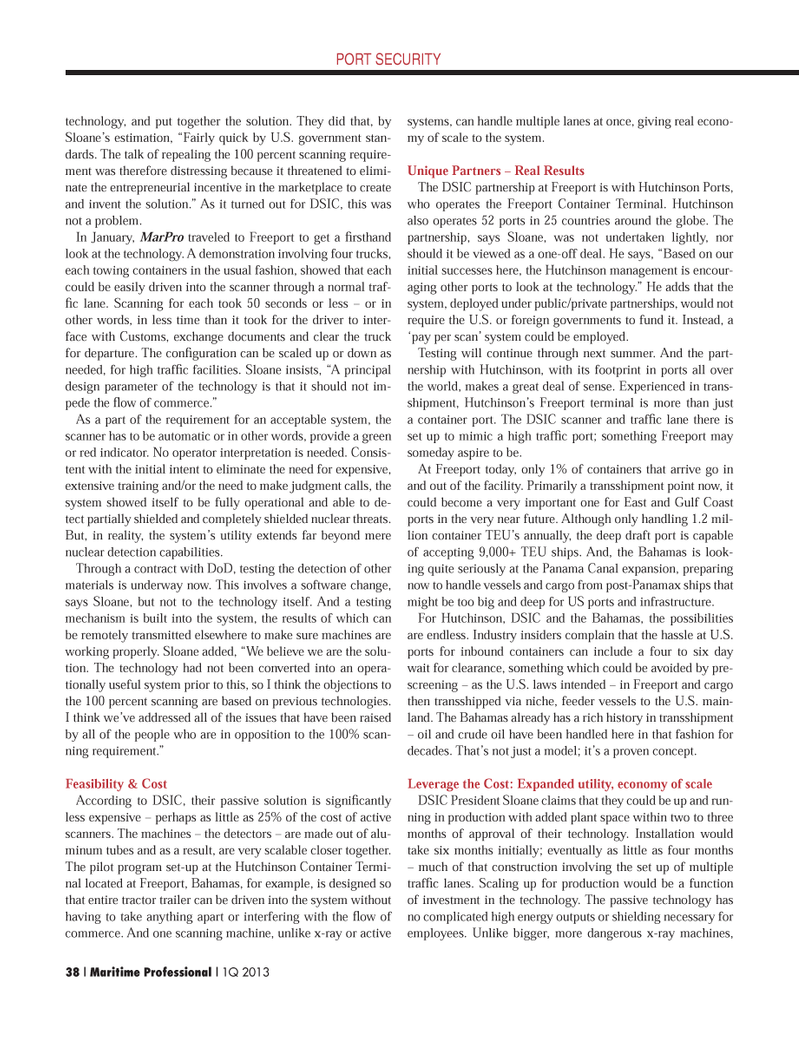
Page 38: of Maritime Logistics Professional Magazine (Q1 2013)
Maritime Risk
Read this page in Pdf, Flash or Html5 edition of Q1 2013 Maritime Logistics Professional Magazine
technology, and put together the solution. They did that, by Sloane?s estimation, ?Fairly quick by U.S. government stan- dards. The talk of repealing the 100 percent scanning require- ment was therefore distressing because it threatened to elimi- nate the entrepreneurial incentive in the marketplace to create and invent the solution.? As it turned out for DSIC, this was not a problem.In January, MarPro traveled to Freeport to get a rsthand look at the technology. A demonstration involving four trucks, each towing containers in the usual fashion, showed that each could be easily driven into the scanner through a normal traf- c lane. Scanning for each took 50 seconds or less ? or in other words, in less time than it took for the driver to inter- face with Customs, exchange documents and clear the truck for departure. The con guration can be scaled up or down as needed, for high traf c facilities. Sloane insists, ?A principal design parameter of the technology is that it should not im-pede the ow of commerce.? As a part of the requirement for an acceptable system, the scanner has to be automatic or in other words, provide a green or red indicator. No operator interpretation is needed. Consis- tent with the initial intent to eliminate the need for expensive, extensive training and/or the need to make judgment calls, the system showed itself to be fully operational and able to de- tect partially shielded and completely shielded nuclear threats. But, in reality, the system?s utility extends far beyond mere nuclear detection capabilities. Through a contract with DoD, testing the detection of other materials is underway now. This involves a software change, says Sloane, but not to the technology itself. And a testing mechanism is built into the system, the results of which can be remotely transmitted elsewhere to make sure machines are working properly. Sloane added, ?We believe we are the solu- tion. The technology had not been converted into an opera- tionally useful system prior to this, so I think the objections to the 100 percent scanning are based on previous technologies. I think we?ve addressed all of the issues that have been raised by all of the people who are in opposition to the 100% scan-ning requirement.? Feasibility & Cost According to DSIC, their passive solution is signi cantly less expensive ? perhaps as little as 25% of the cost of active scanners. The machines ? the detectors ? are made out of alu- minum tubes and as a result, are very scalable closer together. The pilot program set-up at the Hutchinson Container Termi- nal located at Freeport, Bahamas, for example, is designed so that entire tractor trailer can be driven into the system without having to take anything apart or interfering with the ow of commerce. And one scanning machine, unlike x-ray or active systems, can handle multiple lanes at once, giving real econo- my of scale to the system. Unique Partners ? Real Results The DSIC partnership at Freeport is with Hutchinson Ports, who operates the Freeport Container Terminal. Hutchinson also operates 52 ports in 25 countries around the globe. The partnership, says Sloane, was not undertaken lightly, nor should it be viewed as a one-off deal. He says, ?Based on our initial successes here, the Hutchinson management is encour- aging other ports to look at the technology.? He adds that the system, deployed under public/private partnerships, would not require the U.S. or foreign governments to fund it. Instead, a ?pay per scan? system could be employed. Testing will continue through next summer. And the part- nership with Hutchinson, with its footprint in ports all over the world, makes a great deal of sense. Experienced in trans- shipment, Hutchinson?s Freeport terminal is more than just a container port. The DSIC scanner and traf c lane there is set up to mimic a high traf c port; something Freeport may someday aspire to be.At Freeport today, only 1% of containers that arrive go in and out of the facility. Primarily a transshipment point now, it could become a very important one for East and Gulf Coast ports in the very near future. Although only handling 1.2 mil- lion container TEU?s annually, the deep draft port is capable of accepting 9,000+ TEU ships. And, the Bahamas is look- ing quite seriously at the Panama Canal expansion, preparing now to handle vessels and cargo from post-Panamax ships that might be too big and deep for US ports and infrastructure.For Hutchinson, DSIC and the Bahamas, the possibilities are endless. Industry insiders complain that the hassle at U.S. ports for inbound containers can include a four to six day wait for clearance, something which could be avoided by pre- screening ? as the U.S. laws intended ? in Freeport and cargo then transshipped via niche, feeder vessels to the U.S. main- land. The Bahamas already has a rich history in transshipment ? oil and crude oil have been handled here in that fashion for decades. That?s not just a model; it?s a proven concept. Leverage the Cost: Expanded utility, economy of scale DSIC President Sloane claims that they could be up and run- ning in production with added plant space within two to three months of approval of their technology. Installation would take six months initially; eventually as little as four months ? much of that construction involving the set up of multiple traf c lanes. Scaling up for production would be a function of investment in the technology. The passive technology has no complicated high energy outputs or shielding necessary for employees. Unlike bigger, more dangerous x-ray machines, PORT SECURITY 38 | Maritime Professional | 1Q 2013MP #1 34-49.indd 38MP #1 34-49.indd 382/22/2013 11:18:04 AM2/22/2013 11:18:04 AM

 37
37

 39
39
